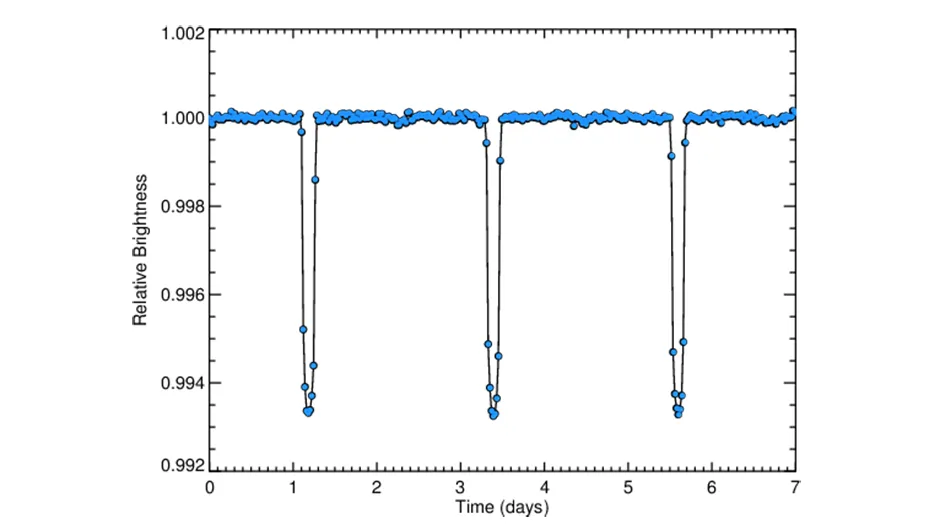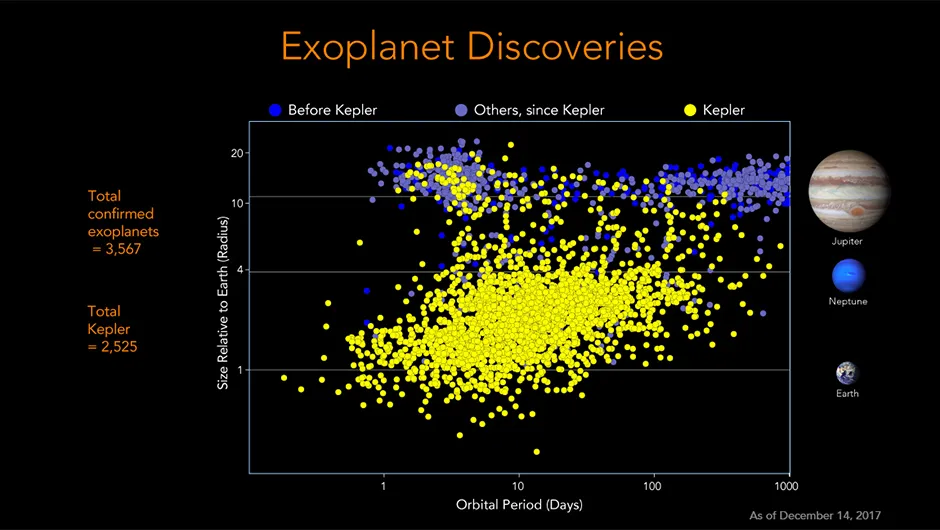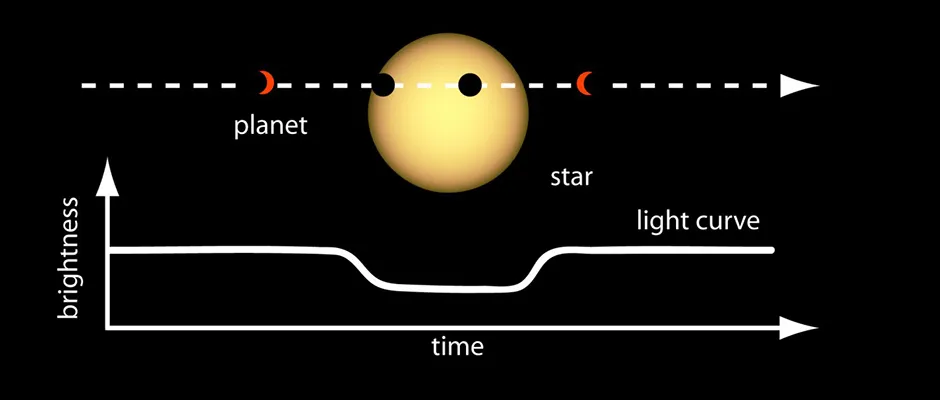More planets than stars: the Kepler space telescope has reveal a wealth of diverse planets that have changed what we know about the Universe. Image Credit: NASA
On 30 October 2018, NASA announced the retirement of the Kepler space Telescope.
This orbiting observatory spent nearly a decade searching stars in the night sky for signs of exoplanets in orbit around them.
Initial data from the mission has revealed a wealth of information that has transformed our view of the Universe.
We spoke to Geert Barentsen, who isDirector of NASA's Kepler Guest Observer Officeat NASA Ames in California, to find out what the mission has achieved so far.

What is the feeling amongst the team, now that Kepler has been retired?
A lot of people might expect us to be a sad because after nine and a half years in space, Kepler has run out of fuel.
But even though it is a bit sad that we are no longer collecting new data, we already have so much data on the ground.
It’s a goldmine and it’s really going to take another decade to sift through it and actually get all the science out of it.
Ultimately the science is produced by human beings on Earth, and not by the robotic telescope in space.
I’m excited about all the discoveries that still lie ahead of us.
How does the data get analysed? Can the public help as well as the scientists?
Absolutely. Kepler is a really sensitive digital camera.
It takes pictures of stars and is completely uninterrupted in this process.
So for about ten years it has been taking pictures of about half a million stars and it measures their brightness.
We end up with very accurate time series data showing how bright a star is over time.
That data reveals a number of things.
If a small exoplanet passes in front of the star as it orbits, it will create a little dip in the light.
But those dips are very small and so it takes a combination of smart algorithms but also human eyes to detect all those small signals in the data.
One approach that has been used very successfully is the use of citizen scientists to look through this data (NB: find out more info here).
They end up finding signals that the algorithms have missed, either because the planet is a bit peculiar or else because there is a strong gravitational shift in the exact timing of when the planets appear.
Do these dips in brightness also allow us to learn anything about what the planet is like?
It’s actually incredible how much information we can get out of those very simple measurements of brightness over time.
The depth of the dip, for example, tells us the size of the planet because if you have a very big planet passing in front of the star, then you get a very deep dip in brightness, and if you have a tiny planet like Earth, which is 100 times smaller in diameter than the Sun, then you get a tiny dip.
And if you measure how frequently the dip occurs, you also find out the rotation period, or the length of one year on that planet.

Was Kepler sensitive enough to pick up dips that could have been caused by exomoons?
There are a few signatures in some of the Kepler light curves that suggest that there might be not only a planet passing a star, but also a tiny extra dip next to the planet.
These always occur at a slightly different time, next to the planet, and right now scientists are debating and using other instruments like the Hubble Space Telescope to find out whether there could be moons around some of the exoplanets.
The jury is still out! Right now people are publishing papers and having the debate, which is how science works.
You see a signal and you study it in more detail to find out whether it’s real or not.
Even now there are some promising signs of exomoons, and that’s crazy because ten years ago we didn’t even know whether planets were common, and now we’re debating the existence of exomoons.
For me personally, Kepler changed the way I look at the night sky.
I’ve always loved looking at the stars at night, but now when I look at the stars, I also see opportunity.
If only our eyes were sensitive enough to see all the exoplanets that Kepler has shown to exist, we would be able to see more planets than stars.
So now I almost feel less lonely when I look at the night sky. I think Kepler has revolutionised how we see the Universe around us.
Has it also introduced new types of planets to us that we didn’t know about before?
Perhaps the biggest surprise to come out of the mission is that a lot of planetary systems and other stars don’t look like our own.
We’ve found an incredible diversity: very compact hot lava planets, fluffy mini Neptune planets, a lot of giant planets, but the most common planet Kepler was able to detect were super Earths.
These are planets that are between the size of Earth and Neptune, so about two or three times the size of Earth.
That’s interesting because there’s no such planet that we know of in our own Solar System, so we’re really struggling to understand what their structure is and what they are made of.
Could our Earth maybe originally have been the core of a one such puffed-up planet?
That’s still very much part of ongoing research that future telescopes like the James Webb Space Telescope might be able to help answer.
Hot Jupiters are another planetary anomaly that we didn’t know about before Kepler, aren’t they?
Hot Jupiters are the first type of exoplanet really that we found back in the 1990s, because a big, Jupiter-sized planet orbiting close to its star is going to block a lot of light.
One of the things Kepler found is that they’re not actually that common, but the fact that they exist is very curious, because you wouldn’t expect such a big planet to be so close to its star.
When a star forms, there’s material left around the star in a sort of pre-planetary disc, but there’s not that much material for big planets to form so close to the star.
Also, there aren’t a lot of volatiles like water, due to the hot temperatures near the star. So the fact that hot Jupiters exist is very surprising.
People are even today coming up with new models to explain how these planets might exist, and perhaps it’s because of gravitational interactions over time, big Jupiters might circle inwards and migrate close to their stars.
That’s really interesting from a scientific perspective.

Are we able to use the knowledge gained from the Kepler mission to learn more about our own Solar System?
Absolutely. Kepler studied stars very intensively and it has been studying the structures of stars using their oscillations and pulsations.
That has given us new insights into the evolution of stars, which ultimately applies to our Sun.
In the last few years, Kepler has been finding planets around stars in clusters. This is interesting because when a star is in a cluster we can measure its age very precisely.
Now we are starting to find a sequence of different planets for which we know precise ages, and that is helping us create new models that show us how planets evolve over time.
Ultimately this helps us understand how the Solar System might have evolved.
What has Kepler told us about other Earth-like rocky planets?
Before Kepler launched, we didn’t know whether Earth-like rocky planets were common around other stars. What Kepler has shown is that they are very common.
We found numerous Earth-sized planets in the habitable zones of their stars - the orbital distance where the temperature on the exoplanet is just right, so that liquid water might be found on its surface.
This is especially true for smaller stars. If you have a smaller star then a smaller planet like Earth is easier to detect because by contrast the size of the dip, the amount of light blocked, is much greater.
Kepler even found a small number of Earth-sized planets in or near the habitable zone of more Sun-like stars.
This is an incredibly different measurement to make because you need to measure the light with a precision of about ten parts per million.
It’s a bit like looking at a mosquito flying in front of the distant headlight of a car.
The most recent estimates suggest that perhaps between 20 and 50 per cent of Sun-like stars have an Earth-like planet in the habitable zone.
These analyses are still continuing, but for the first time we know that Earth is definitely not alone, in terms of a planet of that size existing in the habitable zone around its star.
What do you think are the chances that there exists an Earth-like planet that humans could live on, if we could get to it?
We have not found any planet that is exactly like Earth, with continents and oceans: so far the only planet like this that we know of is our own planet.
But if you consider the factors you might need for such a planet to exist, the first question you would ask is ‘how common are planets to begin with?’
Now we know that Earth-like planets in the habitable zone are common. The beauty of Kepler is that it’s not just a standalone mission.
NASA has a strategic objective to answer the question ‘are we alone?’
Kepler was the first step in this endeavour, and now future missions such as the James Webb Space Telescope will look more closely at the planets we’ve found.
James Webb has really sensitive spectrographs that split the light from stars into different colours, and this might reveal the chemical fingerprints, the different atoms and molecules in the atmospheres of some of the exoplanets.
It might be able to detect molecules such as water, or CO2 or methane.
On Earth we know that those molecules are linked to life but on another planet they could also be a sign of volcanic activity, so it’s never going to be easy to know in the near future whether or not there is life on an exoplanet.
But we are slowly, in a very strategic way closing in on understanding whether such planets might exist.

Are we able to use the knowledge gained from the Kepler mission to learn more about our own Solar System?
Absolutely. Kepler studied stars very intensively and it has been studying the structures of stars using their oscillations and pulsations.
That has given us new insights into the evolution of stars, which ultimately applies to our Sun.
In the last few years, Kepler has been finding planets around stars in clusters.
This is interesting because when a star is in a cluster we can measure its age very precisely.
Now we are starting to find a sequence of different planets for which we know precise ages, and that is helping us create new models that show us how planets evolve over time.
Ultimately this helps us understand how the Solar System might have evolved.
What has Kepler told us about other Earth-like rocky planets?
Before Kepler launched, we didn’t know whether Earth-like rocky planets were common around other stars.
What Kepler has shown is that they are very common.
We found numerous Earth-sized planets in the habitable zones of their stars - the orbital distance where the temperature on the exoplanet is just right, so that liquid water might be found on its surface.
This is especially true for smaller stars. If you have a smaller star then a smaller planet like Earth is easier to detect because by contrast the size of the dip, the amount of light blocked, is much greater.
Kepler even found a small number of Earth-sized planets in or near the habitable zone of more Sun-like stars.
This is an incredibly different measurement to make because you need to measure the light with a precision of about ten parts per million.
It’s a bit like looking at a mosquito flying in front of the distant headlight of a car.
The most recent estimates suggest that perhaps between 20 and 50 per cent of Sun-like stars have an Earth-like planet in the habitable zone.
These analyses are still continuing, but for the first time we know that Earth is definitely not alone, in terms of a planet of that size existing in the habitable zone around its star.
What do you think are the chances that there exists an Earth-like planet that humans could live on, if we could get to it?
We have not found any planet that is exactly like Earth, with continents and oceans: so far the only planet like this that we know of is our own planet.
But if you consider the factors you might need for such a planet to exist, the first question you would ask is ‘how common are planets to begin with?’
Now we know that Earth-like planets in the habitable zone are common.
The beauty of Kepler is that it’s not just a standalone mission.
NASA has a strategic objective to answer the question ‘are we alone?’
Kepler was the first step in this endeavour, and now future missions such as the James Webb Space Telescope will look more closely at the planets we’ve found.
James Webb has really sensitive spectrographs that split the light from stars into different colours, and this might reveal the chemical fingerprints, the different atoms and molecules in the atmospheres of some of the exoplanets.
It might be able to detect molecules such as water, or CO2 or methane.
On Earth we know that those molecules are linked to life but on another planet they could also be a sign of volcanic activity, so it’s never going to be easy to know in the near future whether or not there is life on an exoplanet.
But we are slowly, in a very strategic way closing in on understanding whether such planets might exist.
